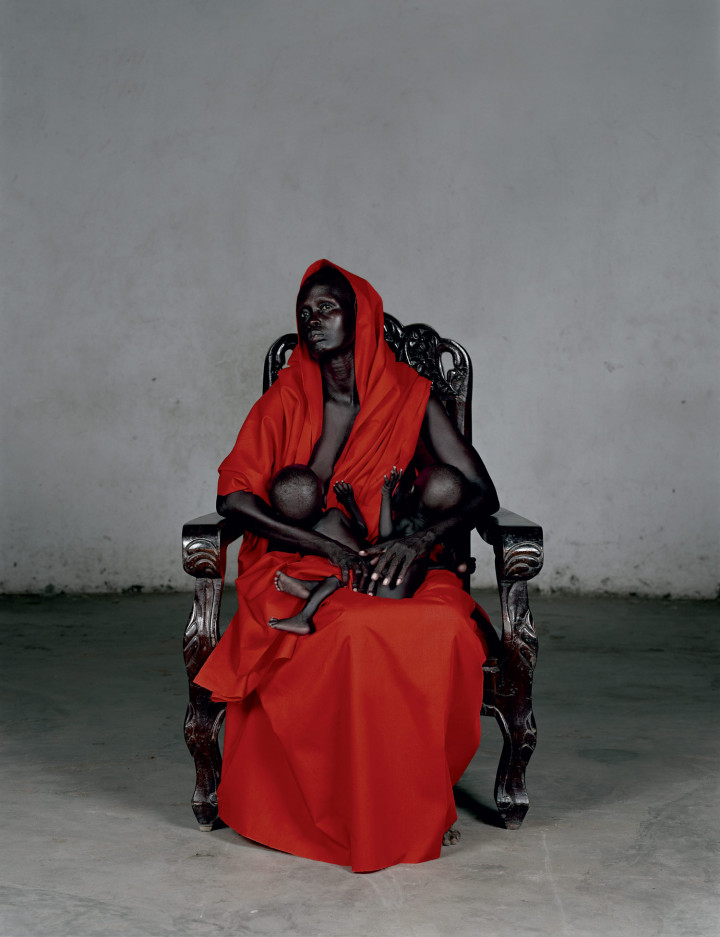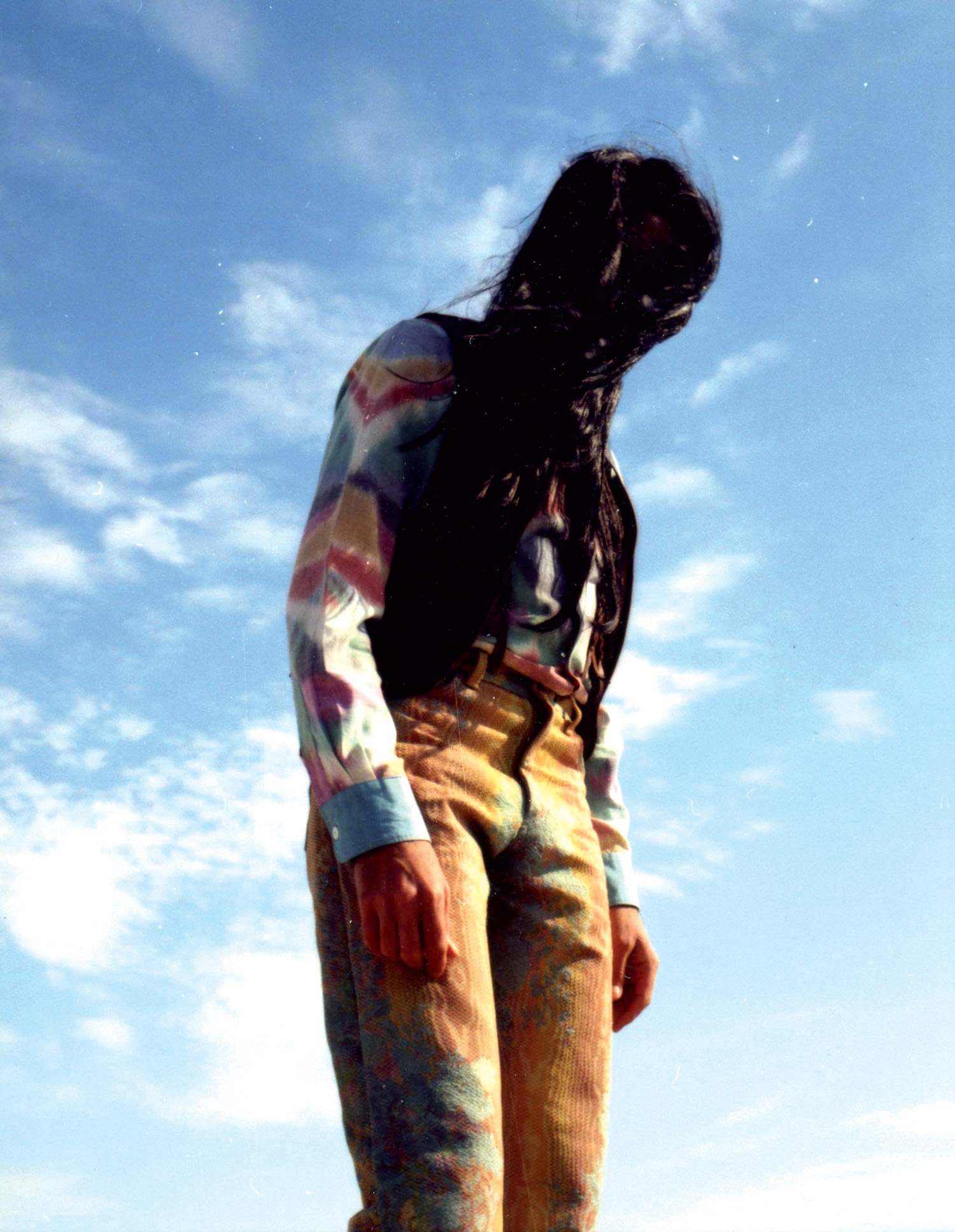
Neville Wakefield: I’ve always understood the iconic aspect of your performances to be serial and anti-narrative. Certain aspects have changed and evolved — different extremities become more or less fetishized, formations become more or less rigid, the palette has changed and so on — but observing these changes over the ten or so years you have been making them is, in many ways, not much different from observing changes in fasteners or materials of a Juddian progression over a similar period. Yet for all their apparent objectivity they are always time-based and therefore subject to their own internal narratives. Is this tension an important aspect of the work?
Vanessa Beecroft: It’s the conflict between trying to achieve an ideal, the illusion of an order, at least as a point of reference, and its ineluctable fall. In the case of the performances with women, this fall is inherent to the subject, as the women to me do not reside in order or geometry because the things that order and geometry represent, power and control, are not there yet. Finally, there is the conflict between order, control, minimalism and chaos, entropy and representation, that duel throughout the performances. The colors of the girls, hair, shoes, background, etc. are nuances that yield more detail as you go back and forth between self-reference and biography. But the work with the black women has different references.
NW: You create loaded situations that do not have narrative qualities. Is this withholding of possibility intentional?
VB: Both. I realized only now that for ten years I have exposed subjects that have possibly undergone trauma while pretending that they were standard examples of women. My incapacity for being objective transforms personal issues into social realizations. Recently, after having ‘cathartiziced’ the trauma onto the audience and traumatized the audience with these crude images of women, I thought I could tell some story, but I am not sure that it belongs to the realm of art.
NW: The performances are scripted, they are created in response to a set of formal conditions and enacted according to a set of instructions. But what happens is that they can sustain that script for only a limited period before breaking down — literally, in the sense that fatigue sets in and structurally in that the rigid formations begin to de-compose. In a structural way, are they battlefields between order and disorder, will and its relaxation?
VB: Yes. And I set this up against my interest as it really aggravates me to witness this loss of precision and this meltdown every time. In fact only those who witness the performances know this as a fundamental aspect of the work. The people who own the photographs are supporting my work but they miss its manifestation in its full form.
NW: Is this also true of the presentations involving food — where the whole thing literally goes to shit?
VB: Wow. I never thought of that. Maybe.

NW: The navy project in some ways seemed unique in that at one level it defied the entropic tendency. Unlike most of your performers who return to an organic social existence, for the naval officers everyday life is as rigid and structured as the VB performance. How did this play into the experience?
VB: The reason I chose the military subject is exactly because it is designed not to fall apart. I chose the subject for the power and rigidity that it represents and how this becomes reflected in the aesthetic. The fact that the military performance was so still was exasperating, as painful as witnessing nudity. The Navy project served as a reference for the project with the girls. How rules reflect on behavior and how that has also a visual effect. How certain realms do not change and are inflexible. I did the Navy and then I didn’t need to do it again.
NW: Can you explain the ‘Homburg syndrome’ and its relationship to your work?
VB: When I was a student I was impressed by the figure of Prince von Homburg by Heinrich von Kleist. I remember (but I should check) that the Prince suffered from amnesia, like many of Kleist’s characters, and that once during a fatal battle, he was unable to give the important order because he was distracted by the thought of his lover. At the moment of greatest responsibility he would lose focus. I feel the same during a performance. My mind slips, I regress to the level of a stranger in the room. I do not even know what is going on. It still happens today. Pictures come out black. I forget to check the last details after all the effort it took to get there. I am overwhelmed by the spectacle and I try a quiet refuge. I also like characters like King Ludwig that lose his mind after beauty — he is obliged to his duty and he let himself go crazy rather than bend to the responsibility he is ought to have — but this also shows that he had no freedom to begin with and that there is no privilege in society in whatever class you belong to. This concept doesn’t apply to my work, it is just a thought.
NW: While attending a performance, I spend much of the time wondering what the girls are thinking. Do you see yourself moving towards more explicatory narratives?
VB: I have been acting unconsciously for a while now out of intuition or impulse. I kept installing girls on stage very assertively and firmly without really knowing why that was happening on a personal level and despite all the critique I would get from the cultural elite. Replicating on the stage the impalpable violence that I wanted the audience to feel, the implicit abuse, the overall injustice that the presence of these naked or dressed bodies on a bare space, a gallery, a museum or a space would give rise to. Making it difficult at times to criticize because it was a codified institution, an art space. A safe environment, intellectually guaranteed. I wanted to shut the audience up, abruptly, sweeten the picture with cultural reference (they are indeed important to me but sometimes redundant) and shovel nudity and the bodies of females in their faces. All of this with grace, beauty kindness and stillness, with classicism that would temper and hide any obvious anger or resentment. I had no ulterior motive, it was a spontaneous act, a performative act, within regulations, refinements, architectural rules and geometry that I would eventually allow to vanish. Today sometimes I have sudden clarifications on a personal level, but unless I understood that they represented something on a sociological level and not just individual, I wouldn’t illustrate it. This is a tip I learned from Marx and Engels’ writings on aesthetics when I was 18 and did an exam with Pasolini’s friend, Francesco Leonetti — the necessity of a combination between the particular and the universal. It’s a principle present in my self-judgment when I work. I refer to art as a way of creating symbols and icons, and leave the narrative as a possible interpretation but not the only way out.
NW: What were the origins of your interest in Sudan and when did you first go there?
VB: November 2005, but I wanted to be there already in May 2005 after I read a little article at the bottom of the New York Times talking about genocide. The interest was just an intuition. Then several facts brought me there for real, like almost meeting the Italian Bishop of the Sudan on the same plane where I was reading the article…

NW: How did the image of you nursing the two Sudanese infants come about?
VB: The day I landed in Rumbek, South Sudan, I felt sick from mastitis. I asked the Bishop if anybody needed mother’s milk and he brought me to the local orphanage. Sister Jacqueline of the Theresa Sisters of Charity introduced me to three malnourished newborns without mothers. One baby girl and two twin boys. I sat there and nursed them for the rest of my stay and never got the babies out of my mind again. I tried to adopt them but my husband was contrary to the concept of exporting people out of context. I sublimated my desire of being their mother by making a picture of it and related it to the environment I was in (a Catholic Mission) and the reference to Italian religious art. I tried three times to realize this image and finally in April when the babies were grown, I shot the final picture. Martin Margiela designed the burned dress and a photographer from New York took the picture in a facsimile studio in a camp while the SPLA (Sudanese Police Liberation Army) was banging at the door thinking that we were trading infants. A really difficult situation. Once the police opened the door and saw the children grabbing onto me — they let me go free. The image of the white Madonna nursing two black Jesus also represents the double face of the humanitarian effort, an effort that doesn’t come without a price for the ones that are helped. It also refers to classic paintings and mother’s love, but mainly it is a true story, a documentary and a symbol I created after my visit there.
NW: It seems to embody so many aspects of your work — at a manifest level the white Madonna/black Jesus invocation reminds me of Oliviero Toscani’s advertising and the ambiguous relationship between the Catholic Church and images of ethnicity, while at a deeper level it speaks to the spiritual bodily issues of the sacrament, your own ambivalence about ingestion, guilt and nourishment and perhaps the corruption of charity itself?
VB: Yes, an ambivalent image that should make everyone happy or everyone mad.
NW: What was the reaction of your Catholic hosts to your involvement in this manner?
VB: The hosts told me that I should not get too close to the people in order not to create vain illusions. I felt very guilty for not having been able to keep a distance from the people. I was drawn to them, physically. The host overall facilitated any operation and supported me immensely even when the local authorities tried to sabotage the entire scope of the trip out of a misunderstanding and had us all almost arrested. In a postwar non-government situation any strange act is considered a threat.
NW: What form do you think the project will have in the end and, if it does end up being a film, do you see it being driven by more traditionally understood narratives?
VB: Maybe not, but I should at least make it visually more traditionally understandable or iconic or beautiful. The video material I collected until now is not special. It falls into the cliché of African footage, it is ethnographic and I abhor this type of image. In this sense I love Herzog’s works and ideals.





